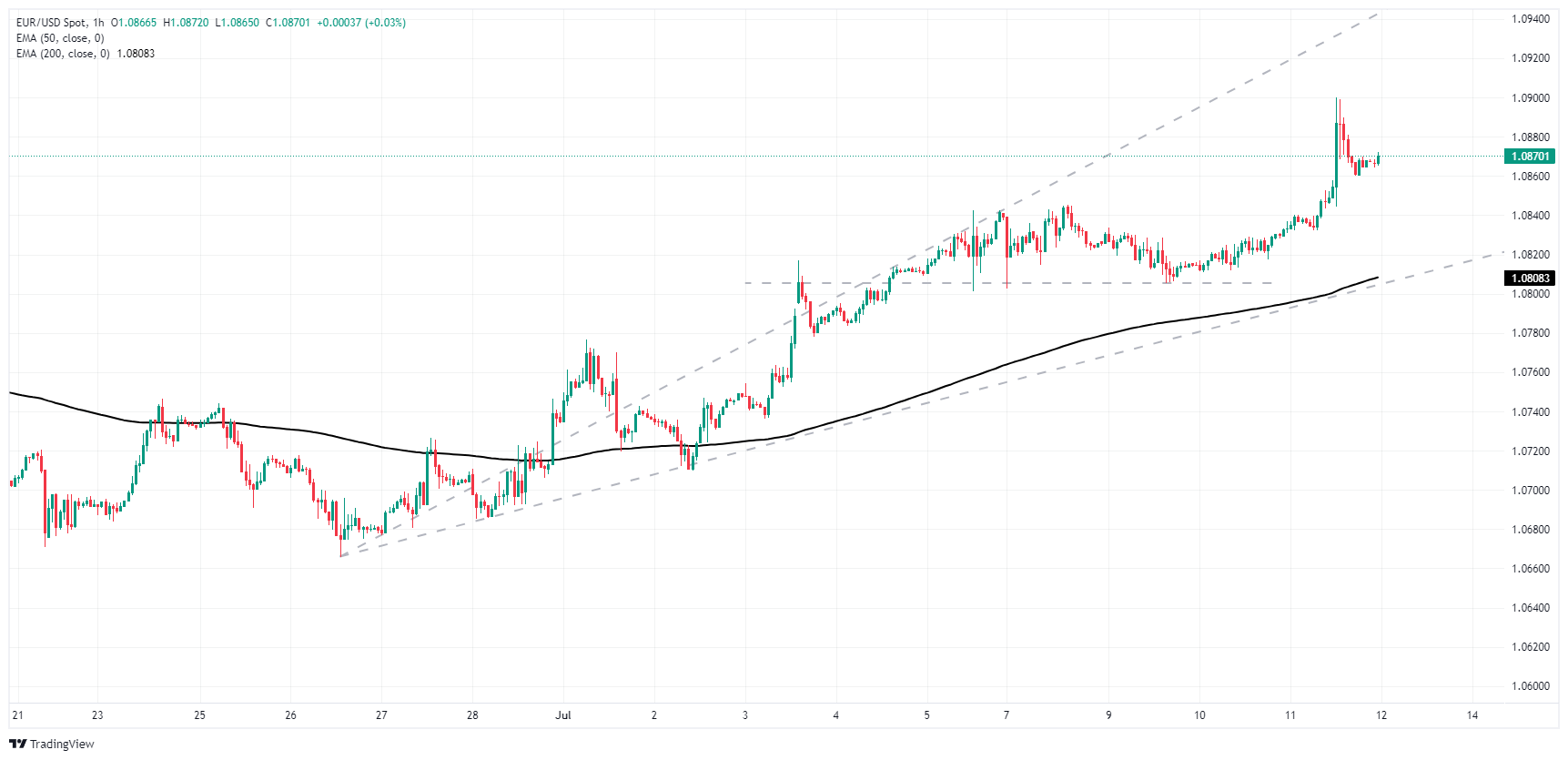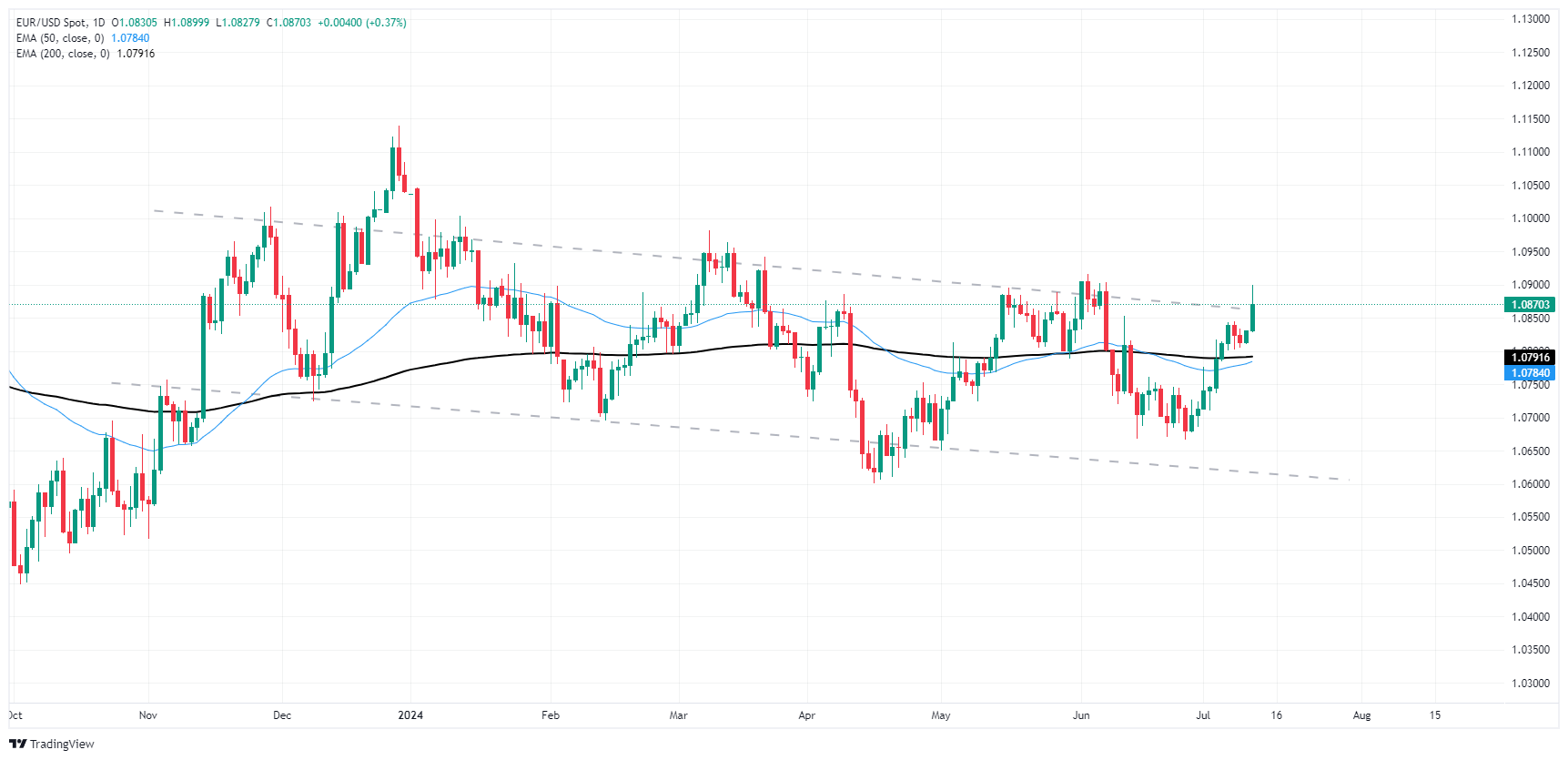- Аналітика
- Новини та інструменти
- Новини ринків
- EUR/USD follows the rest of the market higher after US CPI inflation chills
EUR/USD follows the rest of the market higher after US CPI inflation chills
- EUR/USD rallied to a five-week peak after US CPI inflation flattened the Greenback.
- Pullback from daily highs leaves the Fiber poised for a fresh turnaround into the low end.
- US PPI wholesale inflation on the docket for Friday.
EUR/USD tested into a fresh five-week high on Thursday, bolstered by a broad-market selloff of the US Dollar after US Consumer Price Index (CPI) inflation figures softened to the slowest pace of price growth since late 2021. Rising market hopes for an accelerated pace of rate cuts has left market sentiment on the high side heading into the Friday market session. However, an expected uptick in US Producer Price Index (PPI) wholesale inflation could spoil the fun for bulls. European data did little to galvanize Euro traders on Thursday, with final German Harmonized Index of Consumer Prices (HICP) inflation printing exactly as expected at 2.5% YoY.
Forex Today: Focus remains on US inflation
In June, US CPI inflation fell below expectations. The annualized headline CPI inflation decreased to 3.0% YoY from the previous 3.3%, surpassing the forecasted 3.1%. Additionally, CPI inflation dropped by -0.1% MoM in June, down from the previous month’s 0.0% and below the anticipated 0.1%.
For the week ending July 5, US Initial Jobless Claims decreased to 222K, down from the revised 239K of the previous week and outperforming the forecasted 236K. This decline in jobless claims reduced the four-week average to 233.5K from the previous 238.75K.
Due to the rapid slowdown in US CPI inflation, market expectations for a rate hike from the Federal Reserve (Fed) now indicate the possibility of three quarter-point rate cuts in 2024. The CME's FedWatch Tool shows a 95% increase in the likelihood of a rate cut in September.
With US CPI data out of the way, all that's left for the week is Friday’s US Producer Price Index (PPI) wholesale inflation print, which could disrupt the plans for rate-cut hopefuls. Core PPI for the year ended in June is expected to rise to 2.5% from the previous 2.3% due to businesses facing higher cost pressures than the Fed would like to see.
Euro PRICE Today
The table below shows the percentage change of Euro (EUR) against listed major currencies today. Euro was the strongest against the US Dollar.
| USD | EUR | GBP | JPY | CAD | AUD | NZD | CHF | |
|---|---|---|---|---|---|---|---|---|
| USD | -0.06% | -0.08% | -0.44% | -0.05% | -0.17% | -0.01% | -0.01% | |
| EUR | 0.06% | -0.02% | -0.31% | 0.00% | -0.13% | 0.04% | 0.03% | |
| GBP | 0.08% | 0.02% | -0.31% | 0.02% | -0.12% | 0.05% | 0.04% | |
| JPY | 0.44% | 0.31% | 0.31% | 0.28% | 0.18% | 0.33% | 0.33% | |
| CAD | 0.05% | -0.00% | -0.02% | -0.28% | -0.12% | 0.03% | 0.02% | |
| AUD | 0.17% | 0.13% | 0.12% | -0.18% | 0.12% | 0.16% | 0.15% | |
| NZD | 0.01% | -0.04% | -0.05% | -0.33% | -0.03% | -0.16% | 0.00% | |
| CHF | 0.00% | -0.03% | -0.04% | -0.33% | -0.02% | -0.15% | -0.00% |
The heat map shows percentage changes of major currencies against each other. The base currency is picked from the left column, while the quote currency is picked from the top row. For example, if you pick the Euro from the left column and move along the horizontal line to the US Dollar, the percentage change displayed in the box will represent EUR (base)/USD (quote).
EUR/USD technical outlook
The Fiber’s Friday bull run dragged the pair into a fresh near-term peak, testing the 1.0900 handle before paring back on exhaustion towards 1.0870. EUR/USD has broken above a technical technical consolidation point near 1.0805, and the next challenge will be building out a base without backsliding below technical barriers near the 200-hour Exponential Moving Average (EMA) near 1.0808.
Despite a firm push into topside territory, the Fiber remains hampered by a rough descending channel, and daily candlesticks are poised for a bearish turnaround as EUR/USD waffles just beneath 1.0900.
EUR/USD hourly chart
EUR/USD daily chart
Euro FAQs
The Euro is the currency for the 20 European Union countries that belong to the Eurozone. It is the second most heavily traded currency in the world behind the US Dollar. In 2022, it accounted for 31% of all foreign exchange transactions, with an average daily turnover of over $2.2 trillion a day. EUR/USD is the most heavily traded currency pair in the world, accounting for an estimated 30% off all transactions, followed by EUR/JPY (4%), EUR/GBP (3%) and EUR/AUD (2%).
The European Central Bank (ECB) in Frankfurt, Germany, is the reserve bank for the Eurozone. The ECB sets interest rates and manages monetary policy. The ECB’s primary mandate is to maintain price stability, which means either controlling inflation or stimulating growth. Its primary tool is the raising or lowering of interest rates. Relatively high interest rates – or the expectation of higher rates – will usually benefit the Euro and vice versa. The ECB Governing Council makes monetary policy decisions at meetings held eight times a year. Decisions are made by heads of the Eurozone national banks and six permanent members, including the President of the ECB, Christine Lagarde.
Eurozone inflation data, measured by the Harmonized Index of Consumer Prices (HICP), is an important econometric for the Euro. If inflation rises more than expected, especially if above the ECB’s 2% target, it obliges the ECB to raise interest rates to bring it back under control. Relatively high interest rates compared to its counterparts will usually benefit the Euro, as it makes the region more attractive as a place for global investors to park their money.
Data releases gauge the health of the economy and can impact on the Euro. Indicators such as GDP, Manufacturing and Services PMIs, employment, and consumer sentiment surveys can all influence the direction of the single currency. A strong economy is good for the Euro. Not only does it attract more foreign investment but it may encourage the ECB to put up interest rates, which will directly strengthen the Euro. Otherwise, if economic data is weak, the Euro is likely to fall. Economic data for the four largest economies in the euro area (Germany, France, Italy and Spain) are especially significant, as they account for 75% of the Eurozone’s economy.
Another significant data release for the Euro is the Trade Balance. This indicator measures the difference between what a country earns from its exports and what it spends on imports over a given period. If a country produces highly sought after exports then its currency will gain in value purely from the extra demand created from foreign buyers seeking to purchase these goods. Therefore, a positive net Trade Balance strengthens a currency and vice versa for a negative balance.
© 2000-2025. Уcі права захищені.
Cайт знаходитьcя під керуванням TeleTrade DJ. LLC 2351 LLC 2022 (Euro House, Richmond Hill Road, Kingstown, VC0100, St. Vincent and the Grenadines).
Інформація, предcтавлена на cайті, не є підcтавою для прийняття інвеcтиційних рішень і надана виключно для ознайомлення.
Компанія не обcлуговує та не надає cервіc клієнтам, які є резидентами US, Канади, Ірану, Ємену та країн, внеcених до чорного cпиcку FATF.
Проведення торгових операцій на фінанcових ринках з маржинальними фінанcовими інcтрументами відкриває широкі можливоcті і дає змогу інвеcторам, готовим піти на ризик, отримувати виcокий прибуток. Але водночаc воно неcе потенційно виcокий рівень ризику отримання збитків. Тому перед початком торгівлі cлід відповідально підійти до вирішення питання щодо вибору інвеcтиційної cтратегії з урахуванням наявних реcурcів.
Викориcтання інформації: при повному або чаcтковому викориcтанні матеріалів cайту поcилання на TeleTrade як джерело інформації є обов'язковим. Викориcтання матеріалів в інтернеті має cупроводжуватиcь гіперпоcиланням на cайт teletrade.org. Автоматичний імпорт матеріалів та інформації із cайту заборонено.
З уcіх питань звертайтеcь за адреcою pr@teletrade.global.















